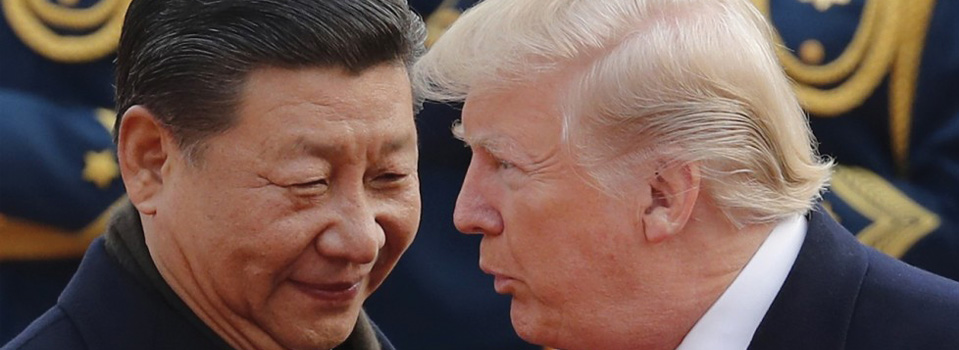AS THE US RECEDES AND CHINA LEADS, TRUMP’S ASIA TRIP SENDS OUT REASSURING SIGNALS

US President Donald Trump’s visit to South Korea, China, Vietnam and the Philippines marks a special moment in a special relationship. The relationship between America and the Indo-Pacific is special because the region is primed for a choice between war and peace.
The moment is special because it breaks with the mercurial president’s habitual propensity to make policy announcements on social media that leave his international interlocutors bewildered or unsure of his meaning. His trip gave him an opportunity to bring America’s weight to bear on Asian affairs in a way that did not upset partners. He grasped the opportunity with élan, cementing a special moment in the transpacific relationship.
He refused to let North Korea’s nuclear ambitions overshadow his message. Nothing gives tinpot dictators more pleasure than to be taken seriously by the leader of the world’s most powerful democracy. This is what Trump does when he responds to a North Korean provocation on social media. Nothing displeases autocrats more than being ignored. This is what he did by focusing on global issues.
Pyongyang is not stupid. It recognises the stakes involved and will not push too far against the boundaries of peace. What Asia must fear more than North Korean actions is the possibility of an irrevocable breakdown of relations between the United States and China, China and Japan, and China and India. China figures in all three equations, but America can help determine how China should feature in them. America is the Indo-Pacific’s offshore power balancer: what it does (or does not do) will tilt strategic relations among partners and adversaries. Trump’s visit to China reiterated his concerns over the direction Beijing could take as it consolidates its position as the world’s second-largest economy. That consolidation is bound to have military and political implications. However, he avoided treating China as a potentially belligerent country.
A revisionist power seeks to change the international order to its advantage. A belligerent power contemplates doing so through war. China today is not Germany in 1914 or 1939. Trump paid China the courtesy of treating it as a peer power – so long as it did not challenge the American underpinnings of the current international system.
There is a problem, however. Those American underpinnings are undermined by Washington’s abdication of the principles of economic multilateralism that have upheld its global prominence since the end of the second world war. During his trip, Trump defiantly defended his decision to pull out of the Trans-Pacific Partnership, a gold-standard economic liberalisation pact, declaring his preference for bilateral pacts in which America could secure its national interests. Chinese President Xi Jinping, eager to pick up America’s mantle on the global marketplace, makes it clear that the Chinese answer to America’s economic withdrawal is more multilateralism, not less.
That, too, is good for Asia. Ultimately, it does not matter for the continent who leads the global economic order, so long as someone does.
If America’s influence recedes, so be it. What is crucial is that the transition from one leader to another occurs without war, even a cold war. What is critical here is that, even as Trump restated his opposition to multilateral commitments that tie America’s hands, he did not oppose China’s determination to lead the multilateral economic order. Just as Beijing has not declared that it will use the South China Sea as a test bed in its attempt to offset American military predominance in the Indo-Pacific, Washington has given no indication that it will subvert Beijing’s global economic role by precipitating a military conflict in that sea.
Whether this peaceful division of international labour between the US and China lasts remains to be seen. It probably will not because economic and military power are the twin products of the global condition. Yet, the Trump trip did not upset the apple cart for the time being. With the Chinese playing along carefully, other Asian countries have time to recalibrate their place in the global economy of war and peace. The 10 members of the Association of Southeast Asian Nations could be a primary beneficiary of this breathing space. Asean is a physical buffer between China and India; its institutional presence mediates among the overlapping influences of the US, China, Japan, India and Russia in the Indo-Pacific. Asean is too weak militarily to threaten the great powers, so no power has any interest in destroying it. However, it cannot be sidelined by any power seeking to place its imprint on Asia.
Trump’s Asian trip underscored his support for the external dimensions of Asean. All in all, the American leader has reassured Asians that the nationalism which brought him to power has space enough for Asian internationalism to flourish.
US President Donald Trump’s visit to South Korea, China, Vietnam and the Philippines marks a special moment in a special relationship. The relationship between America and the Indo-Pacific is special because the region is primed for a choice between war and peace.
The moment is special because it breaks with the mercurial president’s habitual propensity to make policy announcements on social media that leave his international interlocutors bewildered or unsure of his meaning. His trip gave him an opportunity to bring America’s weight to bear on Asian affairs in a way that did not upset partners. He grasped the opportunity with élan, cementing a special moment in the transpacific relationship.
He refused to let North Korea’s nuclear ambitions overshadow his message. Nothing gives tinpot dictators more pleasure than to be taken seriously by the leader of the world’s most powerful democracy. This is what Trump does when he responds to a North Korean provocation on social media. Nothing displeases autocrats more than being ignored. This is what he did by focusing on global issues.
Pyongyang is not stupid. It recognises the stakes involved and will not push too far against the boundaries of peace. What Asia must fear more than North Korean actions is the possibility of an irrevocable breakdown of relations between the United States and China, China and Japan, and China and India. China figures in all three equations, but America can help determine how China should feature in them. America is the Indo-Pacific’s offshore power balancer: what it does (or does not do) will tilt strategic relations among partners and adversaries. Trump’s visit to China reiterated his concerns over the direction Beijing could take as it consolidates its position as the world’s second-largest economy. That consolidation is bound to have military and political implications. However, he avoided treating China as a potentially belligerent country.
A revisionist power seeks to change the international order to its advantage. A belligerent power contemplates doing so through war. China today is not Germany in 1914 or 1939. Trump paid China the courtesy of treating it as a peer power – so long as it did not challenge the American underpinnings of the current international system.
There is a problem, however. Those American underpinnings are undermined by Washington’s abdication of the principles of economic multilateralism that have upheld its global prominence since the end of the second world war. During his trip, Trump defiantly defended his decision to pull out of the Trans-Pacific Partnership, a gold-standard economic liberalisation pact, declaring his preference for bilateral pacts in which America could secure its national interests. Chinese President Xi Jinping, eager to pick up America’s mantle on the global marketplace, makes it clear that the Chinese answer to America’s economic withdrawal is more multilateralism, not less.
That, too, is good for Asia. Ultimately, it does not matter for the continent who leads the global economic order, so long as someone does.
If America’s influence recedes, so be it. What is crucial is that the transition from one leader to another occurs without war, even a cold war. What is critical here is that, even as Trump restated his opposition to multilateral commitments that tie America’s hands, he did not oppose China’s determination to lead the multilateral economic order. Just as Beijing has not declared that it will use the South China Sea as a test bed in its attempt to offset American military predominance in the Indo-Pacific, Washington has given no indication that it will subvert Beijing’s global economic role by precipitating a military conflict in that sea.
Whether this peaceful division of international labour between the US and China lasts remains to be seen. It probably will not because economic and military power are the twin products of the global condition. Yet, the Trump trip did not upset the apple cart for the time being. With the Chinese playing along carefully, other Asian countries have time to recalibrate their place in the global economy of war and peace. The 10 members of the Association of Southeast Asian Nations could be a primary beneficiary of this breathing space. Asean is a physical buffer between China and India; its institutional presence mediates among the overlapping influences of the US, China, Japan, India and Russia in the Indo-Pacific. Asean is too weak militarily to threaten the great powers, so no power has any interest in destroying it. However, it cannot be sidelined by any power seeking to place its imprint on Asia.
Trump’s Asian trip underscored his support for the external dimensions of Asean. All in all, the American leader has reassured Asians that the nationalism which brought him to power has space enough for Asian internationalism to flourish.

